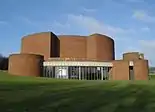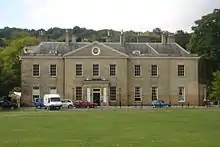List of landmarks and buildings of Brighton and Hove
The city of Brighton and Hove (made up of the towns of Brighton and Hove) on the south coast of England, UK has a number notable buildings and landmarks.

The Brighton Marine Palace and Pier
Extant
Buildings and structures

The Royal Pavilion

Brunswick estate and Embassy Court.
- Bedford Hotel, the present building being a replacement for one of Brighton's oldest and grandest hotels
- Brighton Centre, a concert venue and conference centre known for hosting conferences for many of the major political parties of the UK
- Brighton Marina
- Brighton Pier (also known as Palace Pier, and as Brighton Marine Palace and Pier)
- Brighton railway station
- The British Engineerium
- The Brunswick estate, Hove (a Regency housing development)
- Churchill Square, the largest shopping centre in Brighton
- The Clock Tower, a prominent landmark between Brighton Station and the seafront
- The County Ground, home of Sussex County Cricket Club
- Duke of York's Picture House, the oldest continuously operating cinema in Britain
- Embassy Court, a starkly modernist 1930s design adjacent to Regency Brunswick Terrace; was a prototype for a proposed redevelopment of the entire seafront. Was refurbished in the mid-2000s.
- Falmer Stadium, the home of Brighton and Hove Albion Football Club
- The Grand Hotel
- The Hanbury Arms incorporates as its ballroom a former mausoleum in an Indian architectural style, built for Edward Sassoon
- Hove railway station
- Kemp Town (a Regency housing development)
- The Lanes, an area of Brighton known for its small, twisting series of pedestrianised streets housing many independent shops
- Marine Gate, a 1930s apartment block in the International/Modern style on the eastern approach to Brighton.
- The Metropole Hotel
- The New England Quarter
- North Laine, sometimes incorrectly referred to as "North Laines", North Laine is a group of streets known for their many independent and bohemian shops
- The Pylons, a pair of three-sided stone pillars either side of the southbound A23 road marking the boundary point of Brighton, and carrying a message of welcome for visitors
- The Regency Town House
- The Royal Pavilion
- Sassoon Mausoleum
- Stanmer House
- The University of Sussex, a radical 1960s campus design by Sir Basil Spence, some of which is listed
- The West Pier
- The Western Pavilion, self-made home of prolific local architect Amon Henry Wilds, son of Amon Wilds and sometime working partner of Charles Busby
- White Lodge, The Cliff, Roedean; an atypically small house by Sir Edwin Lutyens, built for Victoria Sackville-West
- Withdean Stadium
Churches and places of worship
This is a small list of the most notable. See also List of places of worship in Brighton and Hove.
Galleries
- Phoenix Arts Association
Murals
- Brighton Belle street mural, a view of the Brighton Belle train in Brighton Station, painted in the arches of the station's forecourt.
- Kissing Coppers, a world-famous mural by the artist Banksy on the side of the The Prince Albert in Trafalgar Street.
Parks and other open air attractions
Extinct
- Brighton and Rottingdean Seashore Electric Railway ("Daddy Long Legs")
- The Royal Suspension Chain Pier
Proposed and/or planned
- The i360 (a.k.a. The Brighton Eye)
See also
- Buildings and architecture of Brighton and Hove
- List of places of worship in Brighton and Hove (which includes some of those insufficiently notable to have been included in this list).
- Brighton and Hove, constituent towns of the city.
This article is issued from Wikipedia. The text is licensed under Creative Commons - Attribution - Sharealike. Additional terms may apply for the media files.


.jpg.webp)


.jpg.webp)
